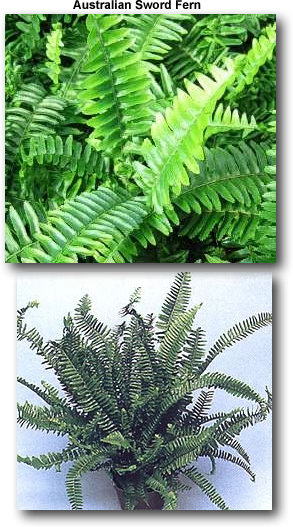Australian Sword Fern
Also known as Kimberley Queen Fern

The Australian Sword Fern (Nephrolepis obliterata) is native to Australia and was introduced to the temperate parts of the United States almost 20 years ago. This hardy fern has become a popular choice for both indoor and outdoor cultivation.
🌱 Air Purification: Excellent air-purifying qualities combined with attractive appearance make this fern perfect for offices, homes, and gardens.
Plant Characteristics
🌿 Growth & Appearance
Size: 24-36 inches (60-90 cm) tall
Leaves: Sword-shaped, sturdy fronds
Growth Rate: Vigorous grower
Durability: Wind-resistant foliage
Shedding: Older fronds don't shed as much as other ferns
🏡 Versatile Uses
Indoor: Table fern, hanging baskets, office plant
Outdoor: Garden borders, path edging, landscape accent
Containers: Excellent for pots and planters
Spacing: 24-48 inches apart in landscape
Zones: USDA zones 9a-11
Growing Requirements
☀️ Light Requirements
Preferred: Partial to full shade
Tolerates: Full morning sun
Indoor: Bright, indirect light
🌡️ Temperature
Optimal: 60-85°F (15-29°C)
Tolerance: Survives above and below range
Cold Hardy: Down to low 20s°F (-6°C)
💧 Watering
Method: Water well, then allow to dry lightly
Caution: More harm from overwatering than underwatering
Avoid: Complete drying out
🌱 Soil & pH
pH Range: 6.1-7.5
Preferred: 6.1-6.5 (mildly acidic)
Drainage: Excellent drainage essential
Salts: Low salt content required
🧪 Fertilization
Rate: 100-150 ppm constant feed
Type: Excel 15-5-15 or similar
Additives: Available Ca, Mg
pH Target: Around 6.0
🐛 Pest Resistance
Natural Resistance: Generally pest-resistant
Low Maintenance: Minimal pest control needed
Hardy Nature: Strong natural defenses
Planting & Propagation
🌱 Propagation Methods
Root Division
Divide the rootball when repotting. Best method for home gardeners.
Spore Propagation
Collect spores from mature fronds. More advanced technique.
🪴 Container Sizes
Table Fern: 6-inch pots
Hanging Baskets: 8-inch and 10-inch baskets
Landscape: 1 and 3-gallon containers
Spacing: 24-36 inches apart for borders
Potting Mix Requirements
🏺 Soil Mix Essentials
Key Elements:
- • Low salt content - Critical for fern health
- • Excellent drainage - Prevents root rot
- • Some peat content - Retains fertilizer and moisture
- • Organic matter - Improves soil structure
Benefits:
- • Keeps fertilizer salts available to roots
- • Maintains water availability to root hairs
- • Provides proper aeration
- • Supports healthy root development
Local Adaptation: Mix composition often depends on local availability. Focus on the key elements above when creating or purchasing potting mix.
Hardiness Zones & Climate
Zone 9a
Down to 20°F (-6.6°C)
Zone 9b
Down to 25°F (-3.8°C)
Zone 10a
Down to 30°F (-1.1°C)
Zone 10b
Down to 35°F (1.7°C)
Zone 11
Above 40°F (4.5°C)
Semi-Hardy
Survives into low 20s°F
Landscape & Design Uses
🌿 Garden Applications
- Border Plantings: Excellent along paths and flower beds
- Fill-in Plant: Great for filling garden areas
- Spacing: Plant 24-36 inches apart for borders
- Mass Planting: 36-48 inches apart for large areas
🪴 Container Applications
- Hanging Baskets: Less shedding than other ferns
- Table Plants: Perfect indoor specimen
- Office Plants: Attractive and low-maintenance
- Patio Containers: Excellent for outdoor living spaces